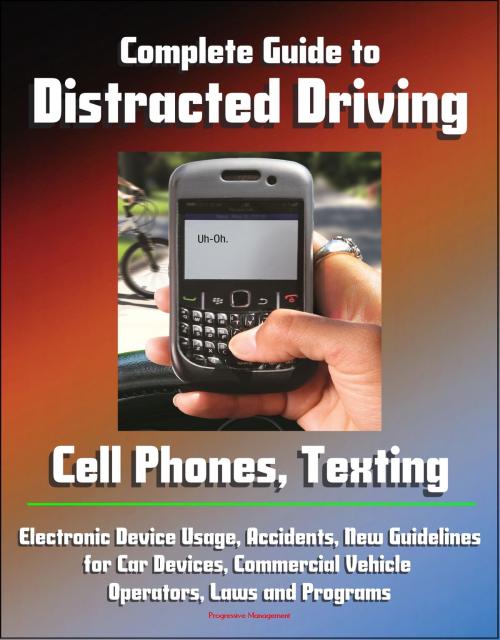Complete Guide to Distracted Driving: Cell Phones, Texting, Electronic Device Usage, Accidents, New Guidelines for Car Devices, Commercial Vehicle Operators, Laws and Programs
Nonfiction, Reference & Language, Transportation, Automotive| Author: | Progressive Management | ISBN: | 9781301514779 |
| Publisher: | Progressive Management | Publication: | August 17, 2013 |
| Imprint: | Smashwords Edition | Language: | English |
| Author: | Progressive Management |
| ISBN: | 9781301514779 |
| Publisher: | Progressive Management |
| Publication: | August 17, 2013 |
| Imprint: | Smashwords Edition |
| Language: | English |
This comprehensive and up-to-date ebook provides a unique guide to the important safety problem of distracted driving, compiling fifteen official documents with details on every aspect of the issue. Contents include:
Part 1: Distracted Driving Overview * Part 2: Young Drivers Report the Highest Level of Phone Involvement in Crash or Near-Crash Incidences * Part 3: Driver Electronic Device Use Observation Protocol * Part 4: Driver Distraction in Commercial Vehicle Operations * Part 5: Distracted Driving Summit * Part 6: Visual-Manual NHTSA Driver Distraction Guidelines For In-Vehicle Electronic Devices * Part 7: Young Drivers Report the Highest Level of Phone Involvement in Crash or Near-Crash Incidences * Part 8: The Impact of Hand-Held and Hands-Free Cell Phone Use on Driving Performance and Safety-Critical Event Risk * Part 9: Distracted Driving 2011 * Part 10: Distraction Effects of Manual Number and Text Entry While Driving * Part 11: The Blueprint for Ending Distracted Driving * Part 12: National Phone Survey on Distracted Driving Attitudes and Behaviors * Part 13: Driver Electronic Device Use in 2010 * Part 14: Four High-Visibility Enforcement Demonstration Waves in Connecticut and New York Reduce Hand-Held Phone Use * Part 15: Statement of Ray Lahood at Hearing On Driven to Distraction: Wireless Devices and Vehicle Safety
The Department of Transportation reports: Distracted driving is a dangerous practice that has become a deadly epidemic. Our latest research shows that nearly 6,000 people died last year in crashes involving a distracted driver, and more than half a million people were injured. This is not a problem caused by just a few negligent drivers. To the contrary, the AAA Foundation for Traffic Safety, a nonprofit educational and research organization, reports that 67 percent of drivers admitted to talking on their cell phones within the last 30 days while behind the wheel, and 21 percent of drivers indicated they had read or sent a text or e-mail message, a figure that rose to 40 percent for those drivers under the age of 35. As shocking as these numbers are, it is clear that this problem is only getting worse, and that the youngest Americans are most at-risk. While the worst offenders may be the youngest, they are not alone. On any given day last year, an estimated 800,000 vehicles were driven by someone who used a hand-held cell phone at some point during their drive. People of all ages are using a variety of hand-held devices, such as cell phones, personal digital assistants, and navigation devices, when they are behind the wheel. However, the problem is not just confined to vehicles on our roads -- it affects all modes of transportation. Experts agree that there are three types of distraction: (1) visual - taking your eyes off the road; (2) manual - taking your hands off the wheel; and (3) cognitive - taking your mind off the road. While all distractions can adversely impact safety, texting is the most egregious because it involves all three types of distraction. In the words of Dr. John Lee of the University of Wisconsin, this produces a "perfect storm."
This comprehensive and up-to-date ebook provides a unique guide to the important safety problem of distracted driving, compiling fifteen official documents with details on every aspect of the issue. Contents include:
Part 1: Distracted Driving Overview * Part 2: Young Drivers Report the Highest Level of Phone Involvement in Crash or Near-Crash Incidences * Part 3: Driver Electronic Device Use Observation Protocol * Part 4: Driver Distraction in Commercial Vehicle Operations * Part 5: Distracted Driving Summit * Part 6: Visual-Manual NHTSA Driver Distraction Guidelines For In-Vehicle Electronic Devices * Part 7: Young Drivers Report the Highest Level of Phone Involvement in Crash or Near-Crash Incidences * Part 8: The Impact of Hand-Held and Hands-Free Cell Phone Use on Driving Performance and Safety-Critical Event Risk * Part 9: Distracted Driving 2011 * Part 10: Distraction Effects of Manual Number and Text Entry While Driving * Part 11: The Blueprint for Ending Distracted Driving * Part 12: National Phone Survey on Distracted Driving Attitudes and Behaviors * Part 13: Driver Electronic Device Use in 2010 * Part 14: Four High-Visibility Enforcement Demonstration Waves in Connecticut and New York Reduce Hand-Held Phone Use * Part 15: Statement of Ray Lahood at Hearing On Driven to Distraction: Wireless Devices and Vehicle Safety
The Department of Transportation reports: Distracted driving is a dangerous practice that has become a deadly epidemic. Our latest research shows that nearly 6,000 people died last year in crashes involving a distracted driver, and more than half a million people were injured. This is not a problem caused by just a few negligent drivers. To the contrary, the AAA Foundation for Traffic Safety, a nonprofit educational and research organization, reports that 67 percent of drivers admitted to talking on their cell phones within the last 30 days while behind the wheel, and 21 percent of drivers indicated they had read or sent a text or e-mail message, a figure that rose to 40 percent for those drivers under the age of 35. As shocking as these numbers are, it is clear that this problem is only getting worse, and that the youngest Americans are most at-risk. While the worst offenders may be the youngest, they are not alone. On any given day last year, an estimated 800,000 vehicles were driven by someone who used a hand-held cell phone at some point during their drive. People of all ages are using a variety of hand-held devices, such as cell phones, personal digital assistants, and navigation devices, when they are behind the wheel. However, the problem is not just confined to vehicles on our roads -- it affects all modes of transportation. Experts agree that there are three types of distraction: (1) visual - taking your eyes off the road; (2) manual - taking your hands off the wheel; and (3) cognitive - taking your mind off the road. While all distractions can adversely impact safety, texting is the most egregious because it involves all three types of distraction. In the words of Dr. John Lee of the University of Wisconsin, this produces a "perfect storm."















